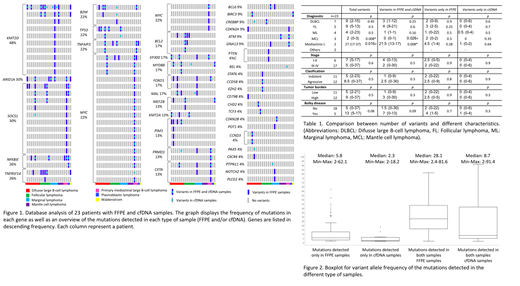Introduction: Non-Hodgkin B lymphomas (NHL-B) are a large group of heterogeneous diseases, with well-defined, histological and clinical features. Currently, the lymph node biopsy is essential for diagnosis, often obtained from hard to reach areas. Our aims with this study was to analyze genetics variants at diagnosis trying to discriminate between different NHL-B histologic subtypes using formalin fixed paraffin embedded (FFPE) tissue sections and circulating tumor free DNA (ctDNA) samples.
Material and Methods: This is a retrospective, cross-sectional, single-center study. Sixty patients were selected with a diagnosis of different NHL-B subtypes: Diffuse large B cell lymphoma (DLBCL), follicular lymphoma (FL), marginal lymphoma (ML), mantle cell lymphoma (MCL) and plasmablastic lymphoma (PL). Sixty FFPE tissue samples and 23 ctDNA specimens obtained at diagnosis were selected. We performed an enrichment panel of 54 genes recurrently mutated in lymphomas (Lymphoma Solution; Sophia Genetics) by next generation sequencing (NGS; NextSeq; Illumina). The depth of 90% of the readings was greater than 2600x. Quantitative variables were expressed as median and range. Categorical variables were expressed as frequency and percentage. The Fisher exact test was used to compare the distribution of categorical variables. The Mann-Whitney test was used to compare differences between quantitative variables. Statistical significance was set at p < 0.05.
Results: Our study shows that 97% (58/60) of patients presented any variant. The most frequently mutated genes were KMT2D, EP300 and SOCS1. Exclusive variants were detected in FL in the genes CCND1, PAX5, CREBBP, BCL2 and REL genes. In the same way, in DLCBL the variants detected in the BRAF, TCF3, XPO1, PIM1, CHD2, ID3 and BCL6 genes were exclusive of this subtype. Furthermore, the genes BCL2 (p=0.0021), CREBBP (p=0.0004), NOTCH2 (p=0.03), PAX5 (p=0.01) and TNFRSF14 (p=0.04) are more frequently altered in patients with FL, ATM (p=0.02) gene in MCL; NFKBIE (p=0.03), CIITA (p=0.02), MYC (p=0.009) and PIM1 (p=0.04) in DLCBL, among which it was found that high-grade lymphomas are more frequently associated with mutations in CHD2 (p=0.02), MYC (p=0.03) and MYD88 (p=0.02; data not shown).
In the subgroup of 23 patients with paired samples (FFPE/ctDNA), 95% (22/23) of patients had mutations in any of the genes on the panel in FFPE tissue samples and 82% (19/23) in ctDNA specimens. The number of variants detected was different depending on the type of sample analysed, 52% of the variants were detected in both specimens, 39 only in FFPE tissue and 9% in ctDNA; Figure 1). In variants detected in both samples, the average value of the VAF was higher that when is detected only in one of the samples (FFPE: 28.1 vs 5.8 (p<0.00001); ctDNA: 8.7 vs. 2.3 ((p<0.0009); Figure 2). Patients with MCL presented lower number of variants and primary mediastinal lymphoma presented higher number of variants compared with the others subtypes (Table 1).
We did not find significant differences in the number of variants depending on the stage, classification, tumour burden or bulky mass (Table 1).
Conclusion: In our study, we were able to identify genetic variables that could characterize different histological groups of NHL-B in FFPE tissue and ctDNA samples, by using a commercial gene panel of NGS.
The mutational profile obtained from ctDNA and FFPE tissue is comparable in all histological subtypes, regardless tumour burden, aggressiveness or stage, throwing each one of them complemental information.
These results support the hypothesis that could be possible to distinguish different histologies through non-invasive strategies, specially oriented to lesions where obtaining a tissue sample is difficult. We are working on the development of clinical-genetic algorithms that allow us to achieve our goal.
No relevant conflicts of interest to declare.
Author notes
Asterisk with author names denotes non-ASH members.


This feature is available to Subscribers Only
Sign In or Create an Account Close Modal